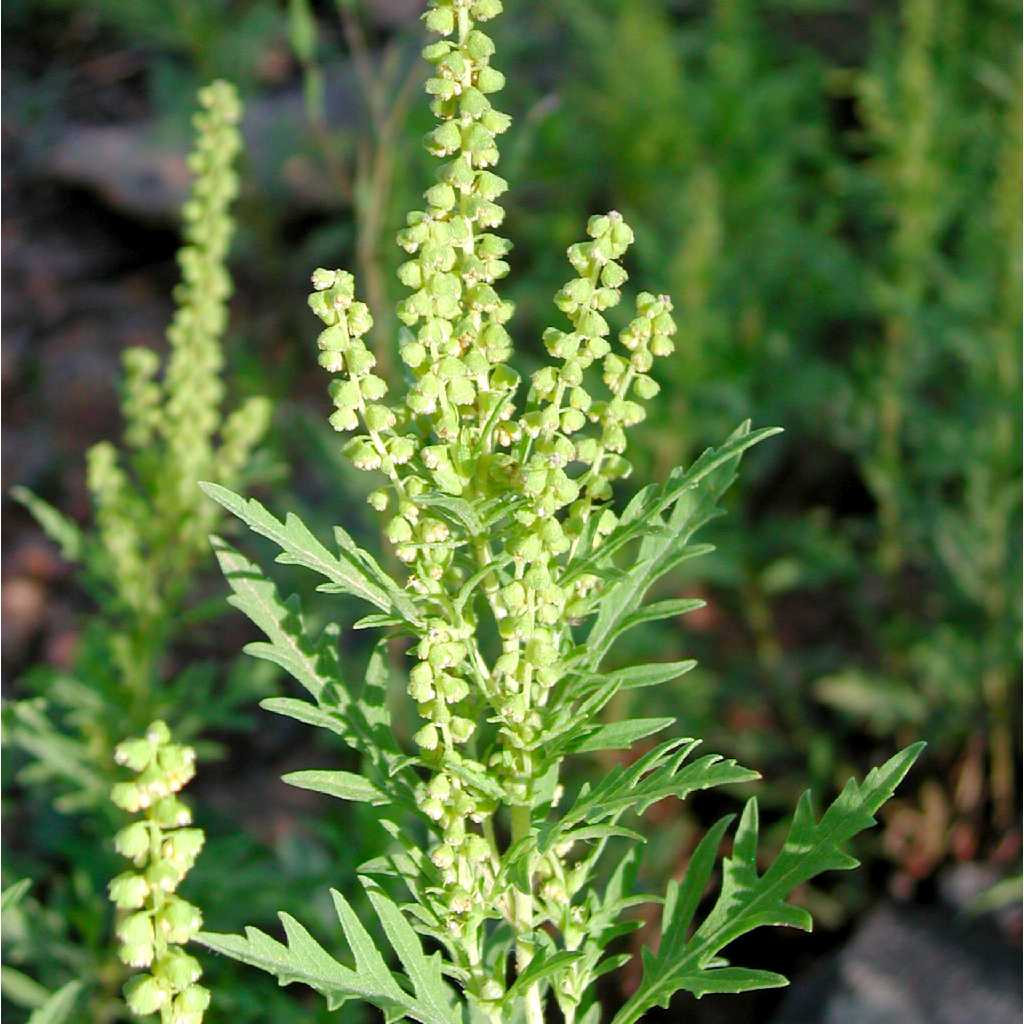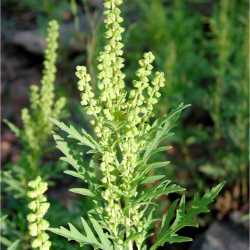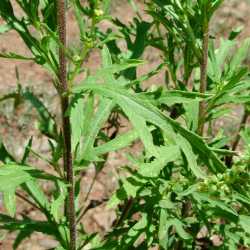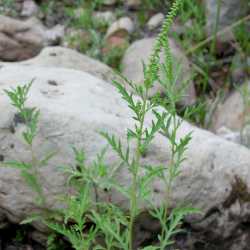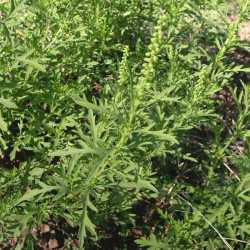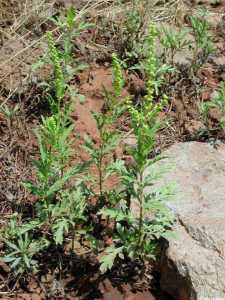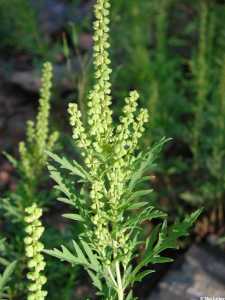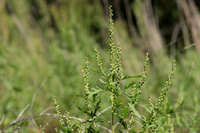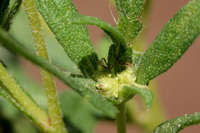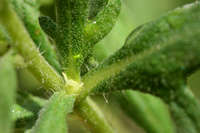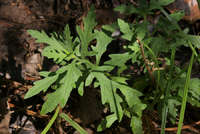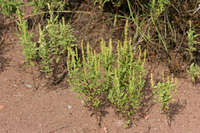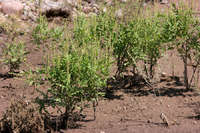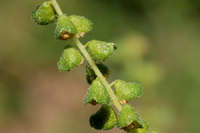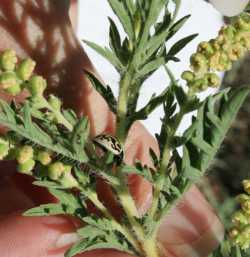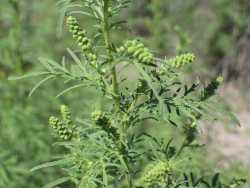Perennials, 10-60(-100+) cm. Stems erect. Leaves proximally opposite, distally alternate; petioles 0-25 mm (often ± winged); blades deltate to lanceolate, 20-60(-140) × 8-35(-50+) mm, pinnately toothed to 1-pinnately lobed, bases cuneate to truncate, ultimate margins entire or toothed, abaxial and adaxial faces hirsutulous to strigose and gland-dotted. Pistillate heads clustered, proximal to staminates; florets 1. Staminate heads: peduncles 0.5-2 mm; involucres obliquely cup-shaped, 2-4(-5) mm diam., hirsutulous; florets 5-15(-30+). Burs: bodies ± obpyramidal to globose, 2-3 mm, hirsutulous, spines or tubercles 0 or 1-6, mostly distal, stoutly conic to acerose, (0.1-)0.5-1 mm, tips straight. 2n = 18, 27, 36, 45, 54, 63, 72, 100-104, 108, 144.
Flowering Jul-Oct(-Dec). Disturbed sites, often wet, alkaline, clay soils; 0-2200 m; Alta., B.C., Man., N.S., Ont., P.E.I., Que., Sask.; Ala., Ariz., Ark., Calif., Colo., Fla., Ga., Idaho, Ill., Ind., Iowa, Kans., La., Maine, Mass., Mich., Minn., Miss., Mo., Mont., Nebr., Nev., N.H., N.Mex., N.Y., N.C., N.Dak., Ohio, Okla., Oreg., Pa., S.C., S.Dak., Tenn., Tex., Utah, Vt., Wash., Wis., Wyo.; Mexico (Baja California, Chihuahua, Coahuila).
Hybrids between Ambrosia psilostachya and A. artemisiifolia have been called A. ×intergradiens W. H. Wagner. Some botanists consider the type of A. cumanensis Kunth (1818) to be conspecific with that of A. psilostachya.
This is a western species that has been reported several times in Indiana, probably mostly as a railroad migrant. It has been reported from the dunes by Peattie and I have a specimen from near Hammond. It has also been reported from Jefferson and Marion Counties, and from the Lower Wabash Valley. In 1933 I found it as a common weed in dry, sandy soil along the C. E. & I. Railroad just south of Emison, Knox County. It is common in sandy soil in a woods about 1 mile southeast of Notre Dame, St. Joseph County (Nieuwland). Ek has found it in two places along railroads in Howard County.
Indiana Coefficient of Conservatism: C = null
Wetland Indicator Status: FAC/FACU
Duration: Perennial
Nativity: Native
Lifeform: Forb/Herb
General: Colonial perennial herb, 20-100 cm tall, arising from deep, creeping rhizomes; herbage rough-pubescent and gland dotted.
Leaves: Opposite below and alternate above, sessile or petiolate, the petioles to 2 cm; blades thick and firm, pinnatifid, with broad midstripe; mostly 2-6 cm long, 1-4 cm wide.
Flowers: Pistillate and staminate flowers in separate heads; all heads discoid; staminate heads pendant in terminal racemes; pistillate heads in the upper leaf axils or in the raceme below the staminate heads. Pistillate heads with 1 floret each, 4-6 mm long, with one set of short tubercles (or lacking). Staminate heads with cup-shaped involucres, 1-2 mm in diameter, papillose-strigose to hispidulous, gland dotted; containing 8-24 disc flowers.
Fruits: Burs brown, obpyramidal to globose, 2-3 mm, hirsutulous, without spines or with up to 6 spines, 1 mm long.
Ecology: Found in disturbed places and streamsides, from 4,000-7,000 ft (1300-2100 m); flowers July-October.
Distribution: Cosmopolitan; in Europe, Australia and S. Africa; throughout most of N. America and every state in the US; south to s MEX.
Notes: Ambrosias are shrubs or herbs with heads of all disk flowers that produce hard fruits or spiny burs. A. psilostachya is a widespread, common species distinguished by being a perennial herb, 10-70cm tall, from long rhizomes that form clonal colonies; leaves that are deeply 1-2X pinnately dissected, and cup-shaped heads. Ambrosia acanthacarpa is similar, but that species is annual and has larger burs (4-8 mm) with 6-30 longer straight spines. Ambrosia confertiflora is also similar, but that species has burs with hooked spines and has a woody taproot rather than rhizomes.
Ethnobotany: Cheyenne used leaves and stems to remedy painful digestion, as a laxative, for labor pain and as a cold treatment. Keres, Kiowa and Deguena tribes used stem and leaf tonic for dandruff. Plant also rolled with sage in Kiowa sweatlodge.
Etymology: Ambrosia is Greek for food of the gods, while psilostachya comes from Greek psilos for smooth or bare and stachy for flower spike.
Synonyms: Ambrosia californica, A. coronopifolia, A. cumanensis, A. psilostachya var. californica, A. psilostachya var coronopifolia, A. psilostachya var. lindheimeriana, A. rugelii
Editor: SBuckley 2010, FSCoburn 2014, AHazelton 2015


